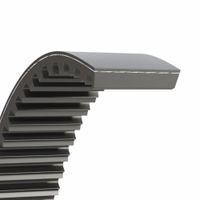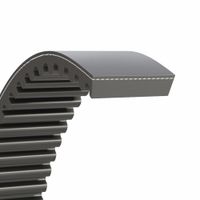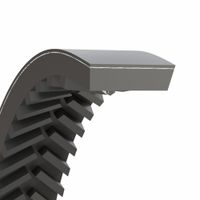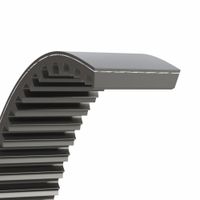Call +(254) 703 030 000 / 751 483 999 / 721 704 777
- Home
- Power Transmission
- Belts Pulleys
- Timing Belts
.....Read More
Frequently Asked Questions
What is the purpose of a timing belt?
The purpose of a timing belt is to synchronize the rotation of the crankshaft and the camshaft(s) in an internal combustion engine, ensuring that the engine's valves open and close at the correct times during each cylinder's intake and exhaust strokes. This synchronization is crucial for the engine to run efficiently and smoothly.
The timing belt is a toothed belt made of durable materials like rubber, reinforced with fibers for added strength. It connects the crankshaft to the camshaft(s), which control the opening and closing of the engine's intake and exhaust valves. By maintaining precise timing between these components, the timing belt ensures that the engine's pistons do not collide with the valves, which could cause significant engine damage.
In addition to its primary role, the timing belt may also drive other components, such as the water pump, oil pump, or balance shafts, depending on the engine design. This makes it a critical component for the overall operation and longevity of the engine.
Regular maintenance and timely replacement of the timing belt are essential, as a failure can lead to catastrophic engine damage. Most manufacturers recommend replacing the timing belt at specific intervals, typically between 60,000 to 100,000 miles, though this can vary based on the vehicle and engine type. Neglecting to replace a worn or damaged timing belt can result in engine misfires, loss of power, or complete engine failure, often requiring costly repairs.
How often should a timing belt be replaced?
A timing belt should typically be replaced every 60,000 to 100,000 miles, depending on the vehicle manufacturer's recommendations. Some newer vehicles may have timing belts designed to last up to 100,000 miles or more. However, it's crucial to consult the owner's manual or a trusted mechanic for the specific interval for your vehicle, as it can vary based on the make, model, and engine type.
In addition to mileage, timing belt replacement should also consider the age of the belt. Even if the mileage interval hasn't been reached, it's generally recommended to replace the timing belt every 5 to 7 years, as the rubber can degrade over time due to environmental factors like heat and humidity.
Signs that a timing belt may need replacement include unusual noises from the engine, difficulty starting the vehicle, or visible wear and tear on the belt itself. However, timing belts often do not show obvious signs of wear before they fail, which is why adhering to the recommended replacement schedule is crucial.
Failure to replace a timing belt at the recommended interval can lead to severe engine damage. In interference engines, a broken timing belt can cause the pistons to collide with the valves, resulting in costly repairs. Therefore, proactive replacement is a preventive measure to avoid unexpected breakdowns and expensive repairs.
In summary, follow the manufacturer's guidelines for timing belt replacement, considering both mileage and time intervals, to ensure the longevity and reliability of your vehicle's engine.
What are the signs of a failing timing belt?
Signs of a failing timing belt include:
1. **Ticking Noise**: A ticking sound from the engine can indicate a failing timing belt, as it may be struggling to rotate the camshaft and crankshaft properly.
2. **Engine Misfires**: If the timing belt is worn or damaged, it can cause the engine's cylinders to open and close out of sync, leading to misfires.
3. **Rough Idling**: A failing timing belt can cause the engine to idle roughly or shake due to improper timing of the engine's components.
4. **Difficulty Starting the Engine**: If the timing belt is severely worn or broken, the engine may not start at all, as the camshaft and crankshaft won't be able to turn in sync.
5. **Loss of Power**: A slipping or failing timing belt can lead to a noticeable loss of power, as the engine's timing is disrupted.
6. **Oil Leaks**: Oil leaking from the front of the engine can be a sign of a failing timing belt cover or gasket, which can lead to belt deterioration.
7. **Check Engine Light**: The check engine light may illuminate if the timing belt is failing, as the engine's sensors detect timing issues.
8. **Visual Wear and Tear**: If accessible, a visual inspection may reveal cracks, fraying, or glazing on the timing belt, indicating it needs replacement.
9. **High-Pitched Squealing**: A high-pitched squealing noise from the front of the engine can indicate a loose or failing timing belt.
10. **Engine Stalling**: A failing timing belt can cause the engine to stall unexpectedly, as the timing of the engine's components is disrupted.
Regular maintenance and timely replacement of the timing belt are crucial to prevent engine damage.
What is the difference between a timing belt and a timing chain?
A timing belt and a timing chain both serve the same fundamental purpose in an internal combustion engine: they synchronize the rotation of the crankshaft and the camshaft(s) to ensure that the engine's valves open and close at the correct times during each cylinder's intake and exhaust strokes. However, they differ in several key aspects:
1. **Material and Construction**:
- **Timing Belt**: Made of rubber with high-tensile fibers (like fiberglass or Kevlar) for strength. It is typically toothed to prevent slipping.
- **Timing Chain**: Made of metal, similar to a bicycle chain, providing greater durability.
2. **Durability and Maintenance**:
- **Timing Belt**: Generally requires replacement every 60,000 to 100,000 miles, depending on the vehicle manufacturer’s recommendations. It is more prone to wear and tear due to its rubber composition.
- **Timing Chain**: Designed to last the lifetime of the engine, often requiring less frequent maintenance. However, it can stretch over time and may need tensioner adjustments or replacement if it becomes noisy.
3. **Noise**:
- **Timing Belt**: Quieter in operation due to its rubber construction.
- **Timing Chain**: Can be noisier, especially as it ages and if it becomes loose.
4. **Cost**:
- **Timing Belt**: Generally less expensive to manufacture and replace, but the cost can add up over time due to periodic replacements.
- **Timing Chain**: More expensive initially, but potentially more cost-effective over the long term due to its longevity.
5. **Engine Design**:
- **Timing Belt**: Allows for more compact engine designs and is often used in smaller or mid-sized engines.
- **Timing Chain**: Typically used in larger, more powerful engines due to its strength and durability.
In summary, the choice between a timing belt and a timing chain depends on factors like engine design, cost considerations, and maintenance preferences.
How much does it cost to replace a timing belt?
The cost to replace a timing belt typically ranges from $300 to $1,000, depending on several factors. These factors include the make and model of the vehicle, the labor rates in your area, and whether additional components need replacement.
1. **Vehicle Make and Model**: Luxury or high-performance vehicles often have more complex engines, which can increase labor time and cost. Parts for these vehicles may also be more expensive.
2. **Labor Costs**: Labor rates vary significantly by location and shop. In areas with a higher cost of living, labor rates can be much higher, contributing to the overall cost.
3. **Parts**: The timing belt itself is not very expensive, usually ranging from $25 to $50. However, many mechanics recommend replacing other components at the same time, such as the water pump, tensioners, and pulleys, which can add to the cost. These additional parts can range from $100 to $500.
4. **Additional Repairs**: If the timing belt has broken, it may have caused damage to the engine, which can significantly increase repair costs. In interference engines, a broken timing belt can lead to bent valves or damaged pistons, requiring extensive repairs.
5. **Shop Type**: Dealerships typically charge more than independent mechanics. However, dealerships may offer warranties on parts and labor, which can be a consideration.
Overall, while the timing belt replacement itself is a routine maintenance task, the total cost can vary widely based on these factors. Regular maintenance and timely replacement can prevent more costly repairs associated with a broken timing belt.
Can a timing belt be repaired, or does it need to be replaced?
A timing belt cannot be repaired and must be replaced. Timing belts are made of rubber and other materials that degrade over time due to heat, tension, and exposure to engine oil. Once a timing belt shows signs of wear, such as cracking, fraying, or stretching, it is no longer reliable and poses a risk of breaking. A broken timing belt can cause severe engine damage, as it synchronizes the rotation of the crankshaft and camshaft, ensuring that the engine's valves open and close at the correct times. If the belt fails, the pistons and valves can collide, leading to costly repairs.
Manufacturers typically recommend replacing the timing belt every 60,000 to 100,000 miles, depending on the vehicle and belt type. It is crucial to follow the manufacturer's maintenance schedule to prevent unexpected failures. During replacement, it is also advisable to inspect and possibly replace related components, such as the water pump, tensioners, and pulleys, to ensure the entire system functions correctly.
Attempting to repair a timing belt is not feasible because the material cannot be restored to its original strength and flexibility. Any temporary fix would be unreliable and could lead to catastrophic engine failure. Therefore, replacing the timing belt with a new one is the only safe and effective solution to maintain engine performance and longevity.
What happens if a timing belt breaks while driving?
If a timing belt breaks while driving, the consequences depend on whether the engine is an interference or non-interference type.
In an interference engine, the timing belt synchronizes the camshaft and crankshaft, ensuring that the engine's valves open and close at the correct times during the piston's movement. If the belt breaks, this synchronization is lost, causing the pistons to collide with the open valves. This can result in severe engine damage, including bent valves, damaged pistons, and potentially a ruined cylinder head. The engine will stop running immediately, and repairs can be costly, often requiring a complete engine rebuild or replacement.
In a non-interference engine, the pistons and valves do not occupy the same space, even if the timing is off. If the timing belt breaks, the engine will stop running, but there is typically no internal damage. The vehicle will lose power, and you will need to coast to a stop. While the repair is less costly than in an interference engine, it still requires replacing the timing belt and possibly the tensioner and water pump.
In both cases, the vehicle will lose power steering and power brakes, making it difficult to control. It's crucial to safely pull over to the side of the road. Regular maintenance and timely replacement of the timing belt according to the manufacturer's recommendations can prevent such failures.




